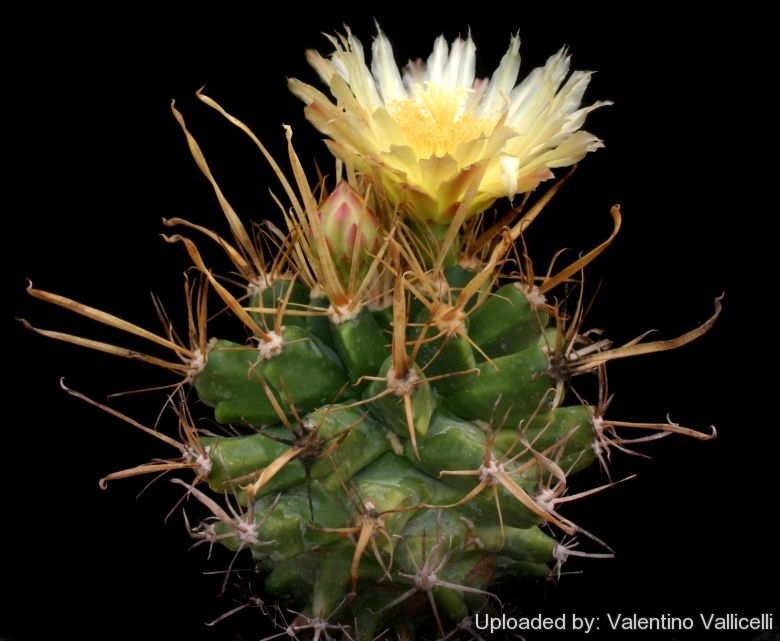
Astrobergia cv. Astrophytum crassispinoides x Leuchtenbergia principis Photo by: Valentino Vallicelli
Hybrid between Astrophytum ornatum and Leuchtenbergia principis. Provenance Kakteengartnerei Albert Plapp, Germany)
Origin and Habitat: Inter-generic hybrid (Provenance Kakteengartnerei Albert Plapp, Germany)
Synonyms:
Description: It is a hybrid cactus offered for sale by the Kakteengartnerei of Albert Plapp (Germany) obtained by crossing ♀ Astrophytum crassispinoides x ♂ Leuchtenbergia principis or vice versa. Its stem is green with distinct odd tubercles and looks very much like a common Ferobergia sp. ( Ferocactus spp. x Leuchtenbergia )SN|12380]]SN|12380]], and some sustain that this plant is not at all an Astrobergia, but one of the innumerable Ferobergias as it lacks the white fleck of Astrophytum and has flattened spines which are slightly hooked like in Ferocactus.
Subspecies, varieties, forms and cultivars of plants belonging to the Astrobergia hybrids goup
 Astrobergia cv. Astrophytum crassispinoides x Leuchtenbergia principis Photo by: Valentino Vallicelli
Astrobergia cv. Astrophytum crassispinoides x Leuchtenbergia principis Photo by: Valentino Vallicelli Astrobergia cv. Astrophytum crassispinoides x Leuchtenbergia principis Photo by: Valentino Vallicelli
Astrobergia cv. Astrophytum crassispinoides x Leuchtenbergia principis Photo by: Valentino Vallicelli Astrobergia cv. Astrophytum crassispinoides x Leuchtenbergia principis Photo by: Valentino Vallicelli
Astrobergia cv. Astrophytum crassispinoides x Leuchtenbergia principis Photo by: Valentino Vallicelli Astrobergia cv. Astrophytum crassispinoides x Leuchtenbergia principis Photo by: Cactus Art
Astrobergia cv. Astrophytum crassispinoides x Leuchtenbergia principis Photo by: Cactus Art Astrobergia cv. Astrophytum crassispinoides x Leuchtenbergia principis Photo by: Valentino Vallicelli
Astrobergia cv. Astrophytum crassispinoides x Leuchtenbergia principis Photo by: Valentino Vallicelli Astrobergia cv. Astrophytum crassispinoides x Leuchtenbergia principis Photo by: Valentino Vallicelli
Astrobergia cv. Astrophytum crassispinoides x Leuchtenbergia principis Photo by: Valentino Vallicelli Astrobergia cv. Astrophytum crassispinoides x Leuchtenbergia principis Photo by: Valentino Vallicelli
Astrobergia cv. Astrophytum crassispinoides x Leuchtenbergia principis Photo by: Valentino VallicelliSend a photo of this plant.The gallery now contains thousands of pictures, however it is possible to do even more. We are, of course, seeking photos of species not yet shown in the gallery but not only that, we are also looking for better pictures than those already present.
Read More... Cultivation and Propagation: Astrobergias are regarded as choice and difficult in cultivation, but despite that they are relatively easy to grow. They are usually seen as grafted plants, but they are able to grow on their own roots, but slow growing. *
Soil: Use mineral well-permeable substratum with little organic matter (peat, humus).
Repotting: Repotting every 2-3 years. It will need a pot with sufficient depth to allow the tap root. As it is especially prone to rot under-pot in a smaller container filled with very porous compost. Use pot with good drainage.
Watering: Water sparingly from March till October, and keep perfectly dry in winter, at temperatures from 5 to 15 degrees centigrade. In the rest period no high atmospheric humidity!!Care must be taken with watering as they tends to become swollen and untidy in growth habit if given too much water and shade.
Exposition: Outside bright sun, filtered sunlight or afternoon shade, inside it needs bright light, and some direct sun. Subject to sunburn if exposed to direct sun for too long. Tends to bronze in strong light, which encourages flowering and heavy spine production.
Hardiness: Reputedly sensitive to frost, but less so if kept on the dry side prior to, and during, cold weather (hardy to -5° C for short periods). However some warmth throughout the year will increase the grower's success (minimum 5° to 8°C during rest season).
Fertilization: During the growing season enrich the soil using a fertilizer rich in potassium and phosphorous, but poor in nitrogen, because this chemical element doesn’t help the development of succulent plants, making them too soft and full of water.
Pests & diseases: It may be attractive to a variety of insects, but plants in good condition should be nearly pest-free, particularly if they are grown in a mineral potting-mix, with good exposure and ventilation. Nonetheless, there are several pests to watch for:
- Red spiders: Sensitive to red spider mite. Overhead watering is helpful in controlling mites.
- Mealy bugs: Occasionally mealy bugs they develop aerial into the new growth among the wool with disfiguring results, but the worst types develop underground on the roots and are invisible except by their effects.
- Scales: Scales are rarely a problem.
- Rot: Rot it is only a minor problem with cacti if the plants are watered and “aired” correctly. If they are not, fungicides won't help all that much.
Propagation: By seeds, grafting or cutting. Seeds germinate in 7-14 days at 21-27° C in spring, remove the glass cover gradually as the plants develops and keep ventilated, no full sun for young plants! The seedlings should not be disturbed until they are well rooted, after which they can be planted separately in small pots.


















